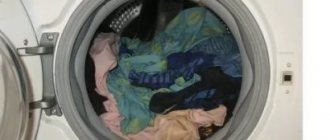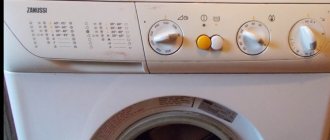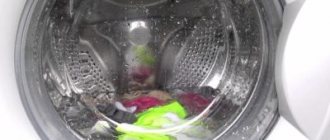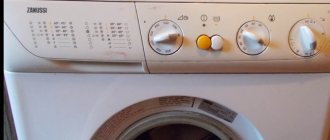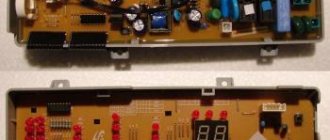Samsung washing machine does not spin or drain water? You must understand that this is a technically complex device. If in semi-automatic washing machines the control was handled by the owner himself, then in modern models the equipment will do everything for the user. All you need to do is put the laundry in the drum, fill the equipment with detergents and activate the appropriate program.
An ordinary washing machine is now equipped with a small, simple computer. Naturally, the increase in the number of functions had a negative impact on the reliability of the equipment. There are more and more components in washing machines that can fail.
What to do if the equipment does not spin things out and does not drain the water? Why is this happening? It is necessary to remember that the devices have a certain washing algorithm. The equipment cannot start the next stage until the previous one is completed.
Therefore, the spin cycle will not start until the machine has drained the liquid after washing. Probably this procedure is the reason. It is necessary to look for the problem step by step, to understand why the drainage of water into the sewer does not work.
How to find a fault?
What to do if the washing machine does not drain water? It is necessary to look for the cause gradually, checking possible options. This is exactly how specialists work; in addition, they rely on their own experience in repairing washing machines.
Before starting diagnostics you need to:
- Turn off power.
- Close the water supply tap.
- Drain the existing liquid and remove the laundry.
Methods that are best not to use to solve the problem
A household washing appliance does not drain water - this is not a reason to try to open its door. Such an unreasonable action may result in the lock on the door breaking or water leaking out of the drum uncontrollably. Also, do not pierce the filter or clog the hose with hard metal objects. If, after carrying out self-diagnosis, it was not possible to set up the operation of the machine, you should not unwind all the components, especially the engine.
The main rule that will protect your Samsung washing machine is constant monitoring of its operation. When the device is in operation, you should not leave it unattended or even leave the house. Such carelessness with regard to household appliances can lead to irreparable damage, resulting in the purchase of a new device.
When solving the problem of a Samsung washing machine breaking down, you need to protect yourself. First of all, start diagnostics after disconnecting the device from the power supply.
Prevention is the best way to protect your machine from breakdowns.
Proper prevention of breakdowns can extend the life of a Samsung washing machine:
- Regularly loading as much laundry into the drum as the instructions allow (each mode has its own weight, from 3.5 to 7-9 kg).
- Clean the filter once every 2-3 weeks, depending on the number of washes.
- Thorough check of utility systems before and during operation of the device - drain hose, water taps, electrical sockets.
Failure to comply with preventive measures can lead to breakdowns, and then to financial expenses for repairs. Therefore, it is better to carefully check all the details before starting to operate the equipment.
Description of errors
Let's look together at the most common causes of the problem and options for their subsequent elimination.
Sewage problems
It’s easy to check the serviceability of the sewer system:
- Disconnect the hose from it and direct it to a bathtub, sink or large container.
- Turn on the drain on the control panel.
- Has water started flowing out of the hose? Then the problem is precisely with the intake of liquid by the sewerage system.
The blockage must be removed. To do this, you can use available tools, special tools, or invite a specialist. If the disconnected hose does not drain, then this is not the problem.
The drain hose is clogged
Has the machine stopped draining water? One possible reason is that the hose is clogged. Determining this is problematic, so it is better to perform preventive cleaning for it. Need to:
- Move the washer to a horizontal position.
- Place a large bag over the engine to prevent any liquid from getting into it.
- Remove the hose clamp and dismantle it.
- Remove the tube from the equipment.
- Place the hose under running cold water.
- Reinstall after cleaning.
Is the blockage serious and the jet does not help to “break through” the pipe? You can try using a long cleaning wire. But be careful not to damage the hose.
Doesn't the drain work after cleaning? Then you need to continue troubleshooting and move on to the next stage.
Air lock in the pump
An air lock can be one of the causes of drainage problems. Since the pump is designed for use with liquid, it is difficult for the equipment to pump it. But you can help the machine:
- Place the drain hose on the floor.
- Activate the appropriate mode on the control panel.
- If water comes out, move the tube into the bath.
Foreign objects have entered the pump
Often, owners forget to take some small items out of their pockets before putting things in the wash. Naturally, all these foreign objects end up in the machine and can disrupt the functioning of the pump. Need to:
- Remove the hub.
- Rinse it well and remove foreign objects.
- Check the rotation of the impeller.
- Put it in place.
Trivial situations
Having decided to deal with the problem yourself, you need to make sure that there really is a breakdown. In some cases, it happens that a full drum of water does not indicate a problem at all. We are talking about the following situations:
- Some modes on Samsung washing machines allow you to stop washing with a full tank. For example, this can be observed when choosing the “Wool” or “Silk” program. Before sounding the alarm, check whether one of the delicate modes has been selected;
- bend of the drain hose. You should check the drain hose to see if it is squashed. If yes, then dealing with the problem is simple - straighten the tube;
- garbage filter clogged. The function of the filter element is to trap debris and prevent it from entering the drain pump. When clogged, the filter does not allow water to pass through to the drain. What to do in this case? It is necessary to unscrew the garbage filter (it is located on the front wall of the SMA, in the lower corner, behind a special door or panel) and rinse its surface;
- clogged sewer pipe or siphon. It happens that the problem is not in the washing machine at all, but in the house communications. It’s easy to check your guess - disconnect the drain hose from the sewer or siphon, and point the end of the tube into the bathtub. Then start the wash, wait for the draining stage. If water begins to flow out of the system unhindered, it means that the pipe or siphon is indeed clogged. You can clean the elements yourself or call a plumber.
If none of the above reasons solve the problem, then we are talking about damage. You will have to partially disassemble the washing machine to identify the problem. Where to start an in-depth check?
How to fix the problem?
Some malfunctions can be corrected yourself; the procedure was described in our article. But often owners cannot cope with the problem without involving a specialist. It is necessary to invite a specialist to carry out diagnostics and repairs.
It is recommended to contact authorized service centers for several reasons:
- Such service centers employ proven and qualified professionals.
- They use advanced equipment for diagnosis and repair.
- It is easier for an authorized service center to obtain the necessary spare parts to replace broken parts.
You can find a list of companies that have received approval to repair Samsung equipment on the manufacturer’s website.
Conclusion
In some cases, you can perform diagnostics and repairs yourself. Often this procedure requires special knowledge and additional equipment. If the necessary repairs are clearly beyond the capabilities of the average user, then you need to invite a professional.
After the drain function is restored, the machine will be able to proceed to spinning the laundry after the wash is completed. The information provided in our article is relevant not only for equipment from Samsung, but also for models from other manufacturers.
What to do if your Samsung washing machine does not spin or drain water? This question is often asked by clients when they turn to our specialists for help. This problem is especially common in older models of Samsung washing machines, released 7-10 years ago. What kind of breakdown can show such a symptom, how to detect this breakdown, and then fix it yourself. Let's talk about this in this publication.
Call the master
Some problems with draining a Samsung washing machine can be solved on your own, even with minimal knowledge about the functioning of the equipment. But for serious breakdowns you can’t do without a specialist.
The best choice when looking for a specialist is to contact authorized service centers. Such companies employ specialists who have the necessary qualifications, have diagnostic equipment and the ability to obtain the necessary spare parts.
The cost of work alone depends on the company’s price list, the type of work performed, the use of additional parts and consumables (for example, sealant).
On average, the price in the capital and large cities is slightly higher than in the regions:
- cleaning the drain filter – from 1,000 rubles;
- pipe cleaning – from 1,200 rubles;
- pump replacement – from 1,500 rubles;
- repair of the control module – from 1,500 rubles;
- replacement of a water level sensor – from 1,300 rubles, etc.
A list of companies that provide warranty service for new washing machines can be found in the documents that are provided when purchasing equipment, as well as on the Internet. For machines whose warranty has expired, you can find a repair company on the World Wide Web.
It is not advisable to contact private individuals, as there is a chance of running into scammers who can lure money for parts and simply disappear.
After completing the repair work, the representative of the household appliance repair company issues a guarantee for the work performed.
Find out more about repairing Samsung washing machines in this section of the site.
Possible causes of failure
We assume that this problem with a Samsung washing machine will be resolved by the user himself. This means that, first of all, we need to outline a list of possible malfunctions that could lead to the washing machine stopping draining and spinning clothes. There are many such reasons, so you will have to put a lot of effort into the search process.
Before looking for the reasons why your washing machine is broken, try simply restarting it; perhaps the problem will go away on its own.
- Blockages. A blockage in the drain hose, pipes and pump blocks the drainage of water, which means the machine will freeze before the spin starts.
- Mechanical or electrical pump. The pump could burn out, or its impeller might not rotate for some reason. Under such conditions, draining water from the washing machine stops working, the washing machine freezes and does not spin.
- Pressostat. When a level sensor fails, it also causes the machine to freeze at the stage of draining waste water, so you will have to check that too.
- Control module. In the worst case scenario, this problem occurs due to a faulty control module. Electronics in general can cause almost any breakdown, and repairing the electronic part of a washing machine is quite expensive.
Failure search algorithm
To find a malfunction that has stopped the washing machine from working and spoiled your nervous system, you must first eliminate basic user errors. What is it about? Firstly, the washing machine freezes at various stages of the washing program when the drum is overloaded with laundry. Secondly, the machine may stop spinning if the user accidentally turns off the spin. Thirdly, the machine may freeze before it has time to drain the water due to a short-term electronics failure; such a failure is usually eliminated by turning off and then turning on the “home assistant”.
Having ruled out absurd causes of failure, you can begin to look for real faults and you need to start with the simple, and then, gradually, move on to the complex.
- First, we check the car for blockages: first we check the garbage filter, then the garbage filter pipe, the drain pipe going from the tank to the garbage filter, then the pump and hose.
- If there are no blockages, we check the pump in detail for functionality, and we check both the mechanical and electrical parts of the drain pump.
- If the pump is in order, next in line is the pressure switch. You need to remove it and check for functionality using a multimeter.
- Well, if the pressure switch is in order, all that remains is to carefully inspect the wiring of the washing machine for breaks, melting and other problems and proceed to checking the control module. But before you do this, read the publication Is it worth repairing electronic modules yourself? It will help you avoid many mistakes.
Possible faults requiring repair
If you have ruled out all the possible situations related to the problems above, but Samsung still does not drain, there is probably a breakdown in the SMA. According to the experience of RemBytTech specialists, most often Samsung washing machines do not drain water in the event of the following malfunctions.
Faulty drain pump - from RUB 1,900.
Due to debris getting into the drain pump, it fails: either the motor burns out (you can’t hear the sounds of the pump running, and the water doesn’t leave), or the impeller blades break off (the motor hums, but the water leaves slowly or does not leave at all).
In the vast majority of cases, it is the breakdown of the drain pump that leads to a lack of drainage in the Samsung.
Signs
The Samsung washing machine is stuck on the wash or rinse cycle and will not drain. The noise of the drain pump is not heard or it hums, but there is no drain. Codes 5E, E2, 5C may be displayed on the screen.
How to fix
A faulty drain pump must be replaced with a new one.
The drain path is clogged - from 1300 rubles.
There is probably a blockage in the drain pipe, drain filter, pump or drain hose.
Signs
You can hear the sounds of the drain pump working, it is trying to pump out the water, but it is still standing in the tank. Errors 5E, E2, 5C may light up on the display.
How to fix
The technician diagnoses the drainage tract, finds the blockage and removes it.
The control module has failed - from 2400 rubles.
Probably, individual radio elements or tracks in the drain pump circuit have burned out on the board. Occasionally the processor burns out. Most often, boards fail due to power surges or moisture.
Signs
The Samsung washing machine does not drain water or drains every once in a while.
How to fix
It is necessary to diagnose the control module. Based on its results, the master:
- replaces burnt-out radioelements with new ones;
- solders faulty tracks and contacts;
- in case of major damage to the control unit, for example, if the processor is burned out, the board is replaced with a new one.
The pressure switch (water level sensor) is broken - from 1900 rubles.
It is responsible for determining the amount of water in the tank. Probably, the pressure switch hose has fallen off or is damaged, or the sensor itself is stuck in the “empty tank” position. For this reason, the control unit believes that there is no water in the machine and does not start draining.
Signs
The Samsung washing machine stopped running with water during the washing or rinsing phase. Perhaps the IE, E7 or 1C codes are lit on the screen.
How to fix
The technician diagnoses the pressure switch and:
- replaces or changes the level sensor hose;
- if the sensor itself breaks down, the unit is completely replaced with a new one.
Signal break in the electrical wiring of the drain pump - from RUB 1,800.
Probably, due to vibrations during the operation of the SMA, the wires frayed or the contacts came off / burned out / oxidized. In the private sector, wiring is often damaged by mice and rats.
Signs
The drain does not work in the Samsung SMA.
Electronics failure
One of the common reasons for a lack of drainage is a software glitch. Most often this happens with models from Indesit. To get rid of the breakdown, you need:
- de-energize the device;
- wait a while;
- turn on the washing machine;
- run the required program again.
If the actions performed did not have the desired effect, it is best to cancel the running program or start the rinse mode, followed by spinning the laundry and draining the water. If after this the washer does not start draining water, the electronic control module has most likely failed.
It is almost impossible to replace it at home, so you will have to turn to specialists.
Filter clogged
Why doesn't the drain in my washing machine work? Often the cause of this may be the formation of a blockage in the filter. During operation, various debris and deposits accumulate in the filter and drainage system pipes. Threads, fluff, foreign objects and corrosion resulting from poor-quality water - everything remains on the filter and creates an impenetrable barrier to water.
Debris buildup is the most common cause of drainage problems. When this error occurs, a digital code will be displayed on the SMA instrument panel. For example, for Samsung models it will be E01.
To eliminate the problem, it will be enough to thoroughly clean the filter located behind a small panel at the bottom of the case. It is worth noting that in the car brands LG, Bosch and Samsung, the protective model is removed in different ways.
What is responsible for draining water in a washing machine?
Before understanding the possible reasons, it is worth clarifying which mechanisms in the washing machine are responsible for draining the water. So, the water pump rules the show, which is essentially a kind of engine with an impeller. This “monster” (more precisely, its motor) rotates, which forces the water to move down and leave the washing machine through hoses and pipes into the sewer.
It would seem that what else, besides the pump (or, in other words, the pump) could be the cause of the malfunction? The pump itself has stopped working, and as a result the water does not flow out. No, such a superficial analysis is not for us. There can be many more reasons for the breakdown. And we will analyze the most common of them in this material.
Clogging of pipes
Drain hoses are an important element of the entire system. They control the distribution of water and prevent it from pouring out of the machine tank during operation. The hose is directly connected to the sewer so that the upper end is higher than the level of the cistern. Improper installation of the hose can also cause the water to fail to drain. In such a situation, the unit will issue the corresponding error code.
Be sure to make sure that no hose is kinked and is in its normal position. Incorrect configuration of the pipes can lead to leaks, water entering electronic components and subsequent short circuits.
Blocking the pump impeller with a large object
Debris caught on the pump impeller can jam the mechanism, stopping the pump from rotating. Even a small object can disrupt the operation of this unit, thereby preventing the water from draining. Removing a foreign object is very simple: just dismantle the filter and use tweezers to remove the unwanted formation. It is very important to remove the interference from the system in time to prevent its breakdown.
Problems with wires
If none of the above methods helped you revive the washing machine, then it may be worth checking the integrity of the wires and contacts. The electronic component of the machine, as a rule, is reliably isolated from water. But it happens that over time, as a result of improper installation or factory huts, they become damaged or worn out.
Problems caused by faulty wires:
- incorrect operation of electronics;
- lack of response to pressing buttons;
- freezing when switching programs;
- danger of short circuit;
- spontaneous shutdown.
After completing the repair and assembling the washing machine, you should check all connections and electronic parts involved in cleaning or debugging. Carefully inspect each wire and hose connected to the pump. Carry out a test run in each wash cycle.
If everything went well, turn off the power to the device and check all parts again for leaks and microcracks. If you notice signs of rust or leakage, disassemble and reconnect the unit. Clean all connections from scale and deposits, add sealant and carefully connect to each other.

